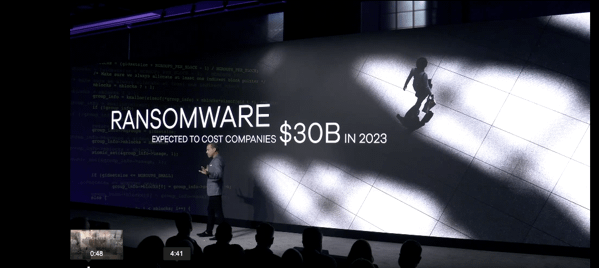Introduction
Recently, I attended Commvault Shift 2023 (virtually) and was left both amazed at their new announcements (learn more below) as well as a bit awestruck overall at just how fast technology is evolving with the rapid surge of AIML into the IT enterprise software landscape.
Probably the biggest announcement from the event is Commvault Cloud, which is powered by something they call Metallic AI – their artificial intelligence engine boasting features like advanced risk governance, automated compliance tools, AI-driven anomaly detection, and new functionalities such as Cleanroom Recovery and Cloudburst Recovery (also covered below).
During the opening keynote, Sanjay Mirchandani, President & CEO of Commvault, emphasised the urgency of the AI-powered threat landscape, and how bad actors are using AI in sophisticated attacks for extortion, business operations cessation, and shutdowns posing massive challenges for enterprises. He went on to underscore the need for proactive measures and the pivotal role Commvault Cloud and Metallic AI play in ensuring organisations stay ahead of the curve.
Ransomware is now a $30 billion dollar business that is applicable to all companies, and all industries, where bad actors are cashing in, and causing chaos through the oversights and perhaps underappreciation of the role of not just Enterprise Security protection, but also the need for smart recovery technologies in the event of an attack. Commvault Cloud is set to be a defence against these attacks and a weapon to proactively take the attack to them. So let’s dive into Commvault Cloud.
What is Commvault Cloud?
Commvault Cloud is a new platform that provides not only a data security solution but also a robust recovery framework for enterprises. It offers the flexibility to operate as self-hosted software, an appliance, or through a new “Commvault As-a-Service” offering. What I think sets it apart is the unique architecture that bifurcates control planes from data, allowing firstly for secure storage across diverse sites and platforms without the need for tightly coupled compute resources.
The crux of Commvault Cloud’s prowess lies in Metallic AI, an integration of advanced AI capabilities that includes generative AI, analytics, and automated remediation (this part was mind-blowing) – a trifecta designed to elevate the platform’s ability to combat evolving threats. By amalgamating machine learning, artificial intelligence, risk scanning, and threat detection, Metallic AI ensures the early identification of security threats, minimising their potential impact and paving the way for expedited recovery times. What I really liked about the sessions from SHIFT is that having a strong recovery capability was placed as equally important as having the best security protection available.
Security protection is paramount but what about recovery?
With this consideration in mind, it’s hardly unexpected that Commvault has introduced notable recovery improvements within Commvault Cloud. Among these, Cleanroom Recovery and Cloudburst Recovery stood out for me as two cool new feature announcements set to end that chaos.
Cleanroom Recovery
In the aftermath of a cyberattack, the importance of a clean and untainted backup cannot be overstated. Equally important is to also have a secure and uncontaminated recovery environment to restore so that you’re not potentially adding hours or days onto recovery times should you find your data infiltrated or useless after a recovery.
Cleanroom recovery is a segregated environment for recovery purposes meaning it is kept away from any production data so that you can keep your recovered data separate guaranteeing the safety of your data against persistent threats or vulnerabilities. This assurance provides peace of mind, ensuring that your recovered data remains untainted and devoid of any potential malware or malicious components.
Cleanroom Recovery is all about making the recovery process fast and efficient. By utilising the power of the cloud (fast spin up) you can get your data back super quick, keeping downtime to a minimum and getting back to normal operations ASAP.
Cloudburst Recovery
Cloudburst utilises infrastructure-as-code and the ability to scale in the cloud to automate the swift and seamless restoration of data to any designated location. Beyond enhancing recovery times (achieving a better RTO), users gain the advantage of automatically reinstating data in the public cloud, facilitating a speedy recovery within a new and untouched cloud environment. (See below for an example of how this extends to other clouds).
Extending to other clouds
Commvault Cloud also ties in with other major cloud platforms, both public and hybrid- Azure, VMware, Google Cloud and Microsoft 365 being some of them. One of the examples that Rajiv Kottomtharayil, Chief Product Officer of Commvault shared was the ability to recover a VMware virtual machine directly into AWS ECS (without any conversion considerations. This means it really isn’t about data protection but about data management.
The Commvault Cloud architecture facilitates smooth migration to and from public clouds, emphasising its role as a comprehensive data management platform rather than solely a security and data protection solution. This adaptability reinforces Commvault Cloud’s significance in the realm of data management, transcending traditional boundaries and limitations to provide a versatile and integrated approach.
The architecture
The architecture of Commvault is designed to offer flexibility, speed, and reliability to its customers.
To achieve this, Commvault has implemented a separation of the control plane, data plane, and storage location which means the inter-reliance between the components opens up a world of flexibility, compatibility and portability thus creating a whole host of use cases that are now possible.
Three fundamental architectural principles have been adopted:
1) Application-aware Indexing
Commvault ensures application awareness through indexing. This indexing process provides comprehensive knowledge about all protected data, enabling intelligent protection and recovery features.
2) Application-agnostic Data Storage:
All data is stored in an application-agnostic format which immediately enhances compatibility and portability while still retaining application awareness for smart storing and application-centric recoveries.
3) Storage Agnosticism:
Commvault Cloud remains storage-agnostic when storing customer data. This agnostic approach provides customers with high flexibility and “any-to-any portability.” It enables the backup of data from any source to any destination and facilitates recovery from anywhere to anywhere.
This architecture is a big step towards an agnostic environment (and I think this is a good thing) meaning it empowers its customers with such a versatile and adaptable architecture (even older generations), allowing them to enjoy the benefits of flexible data management and seamless recovery operations.
In Closing and Final Thoughts
Commvault Cloud is bound to be a game changer, and certainly, its potential is what left me both awestruck and amazed – its machine-learning capability that underpins Commvault Cloud means that Commvault stands as a steadfast ally in the battle for data security and recovery for organisations embarking on their digital transformation journeys without worrying about Ransomware attacks, bad actors or slow recoveries.
I am looking forward to the next one from Commvault, as the groundbreaking announcements they announced at SHIFT truly left me impressed.
To watch the on-demand event, visit https://discover.commvault.com/event-shift-launch-on-demand-thank-you.html






